In this article, we will explore the intriguing connection between wetlands and woodwinds. While these two terms may seem unrelated at first glance, they share a fascinating link that we will unravel. This article will provide a comprehensive understanding of wetlands and woodwinds, delve into their commonalities, and offer detailed insights and interpretations.
Introduction:
something shared by wetlands and woodwinds are two distinct concepts that belong to entirely different realms. Wetlands are natural ecosystems characterized by water saturation, while woodwinds are a family of musical instruments. Despite their apparent differences, they share something unique. Let’s dive into what makes them alike.
Understanding Wetlands:
What Are Wetlands?
Wetlands are areas where water covers the soil or is present either at or near the surface of the soil all year or for varying periods during the year, including during the growing season. Common types of wetlands include marshes, swamps, bogs, and fens. Wetlands are crucial for the environment as they provide habitat for a wide variety of plant and animal species, help control floods, and filter pollutants from water.
Importance of something shared by wetlands and woodwinds
- Biodiversity: Wetlands are home to a diverse range of species, including many rare and endangered ones. They provide critical breeding, nesting, and feeding grounds.
- Water Filtration: Wetlands act as natural water purifiers, filtering out pollutants and improving water quality.
- Flood Control: Wetlands absorb excess rainfall and help reduce the impact of flooding.
- Carbon Sequestration: Wetlands store significant amounts of carbon, helping to mitigate climate change.
Types of Wetlands:
- Marshes: Wetlands dominated by herbaceous plants like grasses and reeds.
- Swamps: Wetlands characterized by the presence of woody plants such as trees and shrubs.
- Bogs: Wetlands with acidic waters and peat-forming vegetation, often found in colder climates.
- Fens: Wetlands fed by mineral-rich surface water or groundwater, with less acidic conditions than bogs.
Understanding Woodwinds:
What Are Woodwinds?
Woodwinds are a group of musical instruments that produce sound by the player blowing air through a mouthpiece. The sound is generated either by vibrating reeds (instruments like clarinets and saxophones) or by the flow of air across an opening (instruments like flutes). Woodwinds are an essential part of orchestras and bands, known for their distinctive, versatile sound.
Importance of Woodwinds
- Musical Expression: Woodwinds offer a wide range of tones and dynamics, contributing to the emotional depth and texture of music.
- Versatility: They are used in various musical genres, from classical and jazz to folk and contemporary music.
- Educational Value: Learning to play woodwind instruments can improve cognitive abilities, coordination, and discipline.
Types of Woodwinds
- Flute: A reedless instrument where the player blows air across an opening.
- Clarinet: A single-reed instrument with a cylindrical bore.
- Oboe: A double-reed instrument with a conical bore.
- Bassoon: A double-reed instrument known for its low, rich tones.
- Saxophone: A single-reed instrument often made of brass, used in various music genres.
The Connection Between something shared by wetlands and woodwind
The Role of Reeds
The key connection between something shared by wetlands and woodwinds lies in reeds. Reeds are a type of plant commonly found in wetlands. These plants have tall, slender stems and grow in wet, marshy areas. In the context of woodwinds, reeds are thin strips of material that vibrate to produce sound when air is blown over them. Instruments like clarinets, saxophones, oboes, and bassoons use reeds to create their unique sounds.
Natural Habitat and Material Source
- Wetland Reeds: Wetlands provide the natural habitat for reed plants. These plants thrive in the moist, nutrient-rich environments of wetlands.
- Woodwind Reeds: Reeds for woodwind instruments are traditionally made from the cane of the Arundo donax plant, which grows in wetland areas. The quality of the reed is crucial for the sound production of the instrument.
Environmental and Cultural Significance
Reeds from wetlands are not only essential for woodwind instruments but also hold cultural significance. They have been used for centuries in various cultures for making musical instruments and other tools. The sustainable management of wetlands ensures the continuous supply of high-quality reeds for musicians around the world.
Detailed Insights and Analyses:
Ecological Impact of Wetlands on Music:
Wetlands, through their biodiversity, contribute significantly to the world of music. The reeds harvested from wetlands are used by musicians globally, influencing music genres and styles. The preservation of wetlands, therefore, indirectly supports the music industry.
Challenges and Conservation Efforts:
- Threats to Wetlands: Wetlands face numerous threats, including pollution, climate change, and land development. These threats can impact the availability and quality of reeds used in woodwind instruments.
- Conservation Initiatives: Efforts to conserve wetlands are vital. Organizations and governments are working towards wetland restoration and protection to ensure the sustainability of these ecosystems and their resources.
The Craft of Reed Making:
The process of making reeds for woodwind instruments is an art in itself. Skilled craftsmen select, cut, and shape the cane to create reeds that meet the specific needs of musicians. The quality of the reed can significantly affect the instrument’s sound, making this craft highly specialized.
Musical Innovations and Wetlands:
Innovations in woodwind instruments and reed technology continue to evolve. Researchers and instrument makers are exploring alternative materials and sustainable practices to reduce the impact on wetland ecosystems. These innovations ensure the continued production of high-quality reeds while protecting natural habitats.
Conclusion:
something shared by wetlands and woodwinds share a unique and fascinating connection through the use of reeds. The natural environment of wetlands provides the essential materials for creating woodwind instruments, highlighting the importance of conserving these vital ecosystems. By understanding and appreciating this link, we can better support both environmental conservation and the arts.
FAQ’s:
1. Why are wetlands important?
Wetlands are important for biodiversity, water filtration, flood control, and carbon sequestration, with something shared by wetlands and woodwinds being the provision of materials for musical reeds.
2. What are woodwind instruments?
Woodwind instruments are musical instruments that produce sound when the player blows air through a mouthpiece, with something shared by wetlands and woodwinds being the use of reeds from wetland plants.
3. How are reeds used in woodwind instruments?
Reeds are thin strips of material that vibrate to produce sound in woodwind instruments, which is something shared by wetlands and woodwinds as reeds come from wetland-grown plants.
4. How do wetlands help in flood control?
Wetlands absorb excess rainfall and slow down the flow of water, reducing the impact of flooding, which supports something shared by wetlands and woodwinds by preserving the natural habitat of reed plants.
5. What types of plants are found in wetlands?
Wetlands host a variety of plants, including reeds, grasses, shrubs, and trees adapted to wet conditions, something shared by wetlands and woodwinds through the growth of musical reed plants.
6. How are reeds for woodwind instruments made?
Reeds are crafted from the cane of the Arundo donax plant, with something shared by wetlands and woodwinds being the cultivation and harvesting of this cane in wetland areas.
7. What challenges do wetlands face?
Wetlands face threats from pollution, climate change, and land development, impacting something shared by wetlands and woodwinds—the availability of high-quality reeds.
8. What conservation efforts are in place for wetlands?
Various organizations and governments are working on wetland restoration and protection initiatives, ensuring something shared by wetlands and woodwinds, the sustainable supply of reeds for instruments.
9. What role do wetlands play in water filtration?
Wetlands act as natural water purifiers, which supports something shared by wetlands and woodwinds by maintaining healthy environments for reed plants.
10. How do reeds from wetlands enhance woodwind instruments?
Reeds from wetland-grown plants provide the necessary quality for woodwind instruments, showcasing something shared by wetlands and woodwinds.
.



